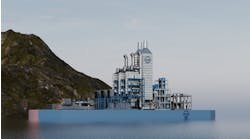Miniature platforms allow Conoco to pursue low-cost gas
Without tax relief, Viking gas revamping relies on technology
Neil PotterTom Knudsen, chairman of Conoco Exploration and Production Europe, spelled it out: "We have to develop the smaller reserves. We have to find ways to squeeze more out of our existing assets. The price of oil isn't going to help us. We are concerned about the UK tax regime. It is at cross-purposes to what we are trying to do. We have to find ways of using innovative technology in a cost-effective way, and this is a fine example."
Contributing Editor
Knudsen was speaking at Barmac's Ardersier fabrication yard in Scotland to several hundred personnel of various disciplines, who have worked on the EPIC contract for two wellhead platforms and an 800-ton reception module for the #140 million Viking-Phoenix development in the southern North Sea. This contract was completed in April. The two platforms will be installed by Seaway Heavy Lifting's Stanislav Yudin this month, ready to produce first gas this fall.
However, Knudsen's remarks have a significance beyond that one development. Conoco has six discoveries in the southern gas basin that it wants to develop - two in the Viking area and four around Caister/Murdoch, with total reserves of 500-600 bcf. There are also opportunities in these areas to handle third party hydrocarbons using its existing infrastructure.
But the continuing uncertainty over Britain's fiscal regime generated UK Chancellor Gordon Brown is making Conoco very wary about committing to developments. Drilling costs, too, are an inhibiting factor. But it is pushing ahead with in-house analysis of these projects in the hope that they can be made viable.
At the same time, with its partners Mobil and Statoil, Conoco is studying Phase 2 of the Jupiter fields development. If they decide to pursue this project, fabrication contracts would be awarded in October 1999.
Phase 2 comprises the Europa, Sinope and Thebe accumulations, containing 200 bcf in UK block 49/22. Development would involve five wells from the three reservoirs tied back to the Ganymede platform, which started production in October 1995. This, like Callisto, is operated remotely from the LOGGS central complex onshore in Lincolnshire.
The Viking improved gas recovery project is due onstream this October and should lead to an extra 100 bcf being produced. A new deck and compression module will be installed on the ED satellite platform. Heerema Hartlepool was awarded the contract in March for the 450t deck for delivery in September. Around 2000, the module may be removed, refurbished and placed on the CD platform for about five years.
Phoenix background
At Phoenix, where the co-venturers are Conoco as operator and BP, the name was chosen to signify the re-birth of the mature Viking gas field, and has been used during the development phase. Once gas production has started, the satellites will be known as Viking KD and LD.There will be two normally unmanned platforms in 20 meters of water to develop the four reservoirs - Viking KD tapping F and Fs (part of the Viking A Field) and Viking LD on Wx and Gn (part of Viking E). These platforms are a lightweight, cost-effective tripod design which Brown & Root calls its "standard gas-gatherer" platform.
Tony Ball, Conoco's project manager, says they are among the smallest yet in the North Sea and will produce 300 MMcf/d. Viking FD weighs 600 tons with a 32 meter by 14 meter deck, while Viking LD weighs 570 tons with similar deck measurements.
The platforms have six slots and three of the risers run down the platform legs. Initially six wells will be required to develop the reserves, put at 500 bcf. Four producing wells, including two existing appraisal wells, will be available for first gas. Jackup Ensco 92 will start drilling deviated horizontal and multilateral wells at the end of this month, which should reduce well numbers, thereby justifying the use of smaller platforms. The cost is put at between #4-5 million/well.
Two to three years from now, when experience of the reservoirs has been gained, a further six wells may be required along with gas compression on Viking B. Fracturing techniques will be used on the Wx wells to improve productivity.
Gas from KD will flow through a 13.5 km, 16-in. pipeline to the Viking B platform complex, where a new 800-ton processing module (known as Triplex) will handle production from the existing Viking and Victor fields plus that from the four new reservoirs. A subsea tee will be used to connect the Viking LD platform to the pipeline.
The seamless pipe was supplied by Mannesmann and the pipelines are being laid by the DLB 160. In an unusual gesture, Conoco has acknowledged the important role of some vendors which supplied equipment ahead of schedule, despite major specification changes in certain cases. These were:
- Grove Dresser Valves - 34 high pressure valves for Phoenix platforms and 150 for Viking B project
- CAC - wellhead control panels and wireline interface panels
- SA Controls - venturi flow meters and flow computers
- NCMP - aluminum helidecks for KD and LD platforms
- Masterpower - control/conditioning equipment on the Viking B electrical power system
- Lewa Pumps - three condensate and three methanol pumps to Viking B
- Derby Specialist Fabrications - five pressure vessels for Viking B.
The project has been run in parallel with Phoenix and was managed by an alliance including Brown & Root, Amec Process and Energy and DNV Asset Integrity Management. All work was performed without having to shut down the platforms. The gas is high in condensate and this has necessitated expanding capacity at the Theddlethorpe terminal in Lincolnshire. A 12 ft by 40 ft separation vessel, built by CMP in Dunkerque, has therefore been added.
Copyright 1998 Oil & Gas Journal. All Rights Reserved.


